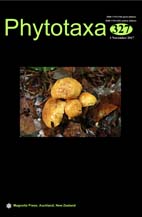Abstract
Pachyptera ventricosa is a rare and poorly known species of liana that occurs in wet forests from the state of Pará, in Brazil. This species is characterized by features that are diagnostic of four genera within tribe Bignonieae: Mansoa, Martinella, Pachyptera, and Tanaecium. The currently recognized P. ventricosa was originally described in Mansoa, but subsequently transferred to Pachyptera based on morphological similarities. In this study, we use a combination of molecular and morphological data to evaluate the current placement of P. ventricosa. We conduct a broad scale molecular phylogenetic study based on 114 sequences of ndhF and PepC representing 112 taxa and members of all genera recognized in Bignonieae. In addition, we also conduct detailed morphological studies of selected characters. Our molecular phylogenetic study indicates that the currently recognized Pachyptera ventricosa is more closely related to members of Mansoa than to Pachyptera. New morphological data corroborates the molecular phylogenetic placement indicating that this species is indeed best placed within Mansoa. We here propose the reestablishment of Mansoa ventricosa, and show the detailed description for this species, along with new distribution information, and the first illustration for this taxon.

